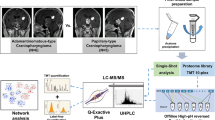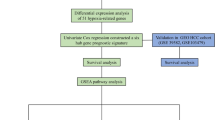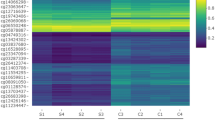Abstract
Aim:
To construct a system for selecting reference genes (RGs) and to select the most optimal RGs for gene expression studies in nasopharyngeal carcinoma (NPC).
Methods:
The total RNAs from 20 NPC samples were each labeled with Cy5-dUTP. To create a common control, the total RNA from 15 nasopharyngeal phlogistic (NP) tissues was mixed and labeled via reverse transcription with Cy3-dUTP. cDNA microarrays containing 14 112 genes were then performed. A mathematical approach was constructed to screen stably expressed genes from the microarray data. Using this method, three genes (YARS, EIF3S7, and PFDN1) were selected as candidate RGs. Furthermore, 7 commonly used RGs (HPRT1, GAPDH, TBP, ACTB, B2M, G6PDH, and HBB) were selected as additional potential RGs. Real-time PCR was used to detect these 10 candidate genes' expression levels and the geNorm program was used to find the optimal RGs for NPC studies.
Results:
On the basis of the 10 candidate genes' expression stability level, geNorm analysis identified the optimal single RG (YARS or HPRT1) and the most suitable set of RGs (HPRT1, YARS, and EIF3S7) for NPC gene expression studies. In addition, this analysis determined that B2M, G6PDH, and HBB were not appropriate for use as RGs. Interestingly, ACTB was the least stable RG in our study, even though previous studies had indicated that it was one of the most stable RGs. Three novel candidate genes (YARS, EIF3S7, and PFDN1), which were selected from microarray data, were all identified as suitable RGs for NPC research. A RG-selecting system was then constructed, which combines microarray data analysis, a literature screen, real-time PCR, and bioinformatic analysis.
Conclusion:
We construct a RG-selecting system that helps find the optimal RGs. This process, applied to NPC research, determined the single RG (YARS or HPRT1) and the set of RGs (HPRT1, YARS, and EIF3S7) that are the most suitable internal controls.
Similar content being viewed by others
Log in or create a free account to read this content
Gain free access to this article, as well as selected content from this journal and more on nature.com
or
References
Bustin SA . Quantification of mRNA using real-time reverse transcription PCR (RT-PCR): trends and problems. J Mol Endocrinol 2002; 29: 23–39.
Bustin SA . Absolute quantification of mRNA using real-time reverse transcription polymerase chain reaction assays. J Mol Endocrinol 2000; 25: 169–93.
Radonic A, Thulke S, Mackay IM, Landt O, Siegert W, Nitsche A . Guideline to reference gene selection for quantitative real-time PCR. Biochem Biophys Res Commun 2004; 313: 856–62.
Bilodeau-Goeseels S, Schultz GA . Changes in the relative abundance of various housekeeping gene transcripts in in vitro-produced early bovine embryos. Mol Reprod Dev 1997; 47: 413–20.
Zhong H, Simons JW . Direct comparison of GAPDH, beta-actin, cyclophilin, and 28S rRNA as internal standards for quantifying RNA levels under hypoxia. Biochem Biophys Res Commun 1999; 259: 523–6.
Huggett J, Dheda K, Bustin S, Zumla A . Real-time RT-PCR normalisation; strategies and considerations. Genes Immun 2005; 6: 279–84.
Radonic A, Thulke S, Bae HG, Muller MA, Siegert W, Nitsche A . Reference gene selection for quantitative real-time PCR analysis in virus infected cells: SARS corona virus, Yellow fever virus, Human Herpesvirus-6, Camelpox virus and Cytomegalovirus infections. Virol J 2005; 2: 7.
Bogaert L, Van Poucke M, De Baere C, Peelman L, Gasthuys F, Martens A . Selection of a set of reliable reference genes for quantitative real-time PCR in normal equine skin and in equine sarcoids. BMC Biotechnol 2006; 6: 24.
Goidin D, Mamessier A, Staquet MJ, Schmitt D, Berthier-Vergnes O . Ribosomal 18S RNA prevails over glyceraldehyde-3-phosphate dehydrogenase and beta-actin genes as internal standard for quantitative comparison of mRNA levels in invasive and noninvasive human melanoma cell subpopulations. Anal Biochem 2001; 295: 17–21.
Schmittgen TD, Zakrajsek BA . Effect of experimental treatment on housekeeping gene expression: validation by real-time, quantitative RT-PCR. J Biochem Biophys Methods 2000; 46: 69–81.
de Jonge HJ, Fehrmann RS, de Bont ES, Hofstra RM, Gerbens F, Kamps WA, et al. Evidence based selection of housekeeping genes. PLoS ONE 2007; 2: e898.
Agulnik M, Siu LL . State-of-the-art management of nasopharyngeal carcinoma: current and future directions. Br J Cancer 2005; 92: 799–806.
Tao Q, Chan AT . Nasopharyngeal carcinoma: molecular pathogenesis and therapeutic developments. Expert Rev Mol Med 2007; 9: 1–24.
Ohl F, Jung M, Xu C, Stephan C, Rabien A, Burkhardt M, et al. Gene expression studies in prostate cancer tissue: which reference gene should be selected for normalization? J Mol Med 2005; 83: 1014–24.
Ohl F, Jung M, Radonic A, Sachs M, Loening SA, Jung K . Identification and validation of suitable endogenous reference genes for gene expression studies of human bladder cancer. J Urol 2006; 175: 1915–20.
Gao Q, Wang XY, Fan J, Qiu SJ, Zhou J, Shi YH, et al. Selection of reference genes for real-time PCR in human hepatocellular carcinoma tissues. J Cancer Res Clin Oncol 2008; 134: 979–86.
Lyng MB, Laenkholm AV, Pallisgaard N, Ditzel HJ . Identification of genes for normalization of real-time RT-PCR data in breast carcinomas. BMC Cancer 2008; 8: 20.
Kidd M, Nadler B, Mane S, Eick G, Malfertheiner M, Champaneria M, et al. GeneChip, geNorm, and gastrointestinal tumors: novel reference genes for real-time PCR. Physiol Genomics 2007; 30: 363–70.
Jung M, Ramankulov A, Roigas J, Johannsen M, Ringsdorf M, Kristiansen G, et al. In search of suitable reference genes for gene expression studies of human renal cell carcinoma by real-time PCR. BMC Mol Biol 2007; 8: 47.
Li Y, Li Y, Tang R, Xu H, Qiu M, Chen Q, et al. Discovery and analysis of hepatocellular carcinoma genes using cDNA microarrays. J Cancer Res Clin Oncol 2002; 128: 369–79.
Wei Q, Li Y, Chen L, Zhang L, He X, Fu X, et al. Genes differentially expressed in responsive and refractory acute leukemia. Front Biosci 2006; 11: 977–82.
Van Zeveren AM, Visser A, Hoorens PR, Vercruysse J, Claerebout E, Geldhof P . Evaluation of reference genes for quantitative real-time PCR in Ostertagia ostertagi by the coefficient of variation and geNorm approach. Mol Biochem Parasitol 2007; 153: 224–7.
Vandesompele J, De Preter K, Pattyn F, Poppe B, Van Roy N, De Paepe A, et al. Accurate normalization of real-time quantitative RT-PCR data by geometric averaging of multiple internal control genes. Genome Biol 2002; 3: RESEARCH0034.
Botteldoorn N, Van Coillie E, Grijspeerdt K, Werbrouck H, Haesebrouck F, Donne E, et al. Real-time reverse transcription PCR for the quantification of the mntH expression of Salmonella enterica as a function of growth phase and phagosome-like conditions. J Microbiol Methods 2006; 66: 125–35.
Spinsanti G, Panti C, Lazzeri E, Marsili L, Casini S, Frati F, et al. Selection of reference genes for quantitative RT-PCR studies in striped dolphin (Stenella coeruleoalba) skin biopsies. BMC Mol Biol 2006; 7: 32.
Saviozzi S, Cordero F, Lo Iacono M, Novello S, Scagliotti GV, Calogero RA . Selection of suitable reference genes for accurate normalization of gene expression profile studies in non-small cell lung cancer. BMC Cancer 2006; 6: 200.
Mamo S, Gal AB, Bodo S, Dinnyes A . Quantitative evaluation and selection of reference genes in mouse oocytes and embryos cultured in vivo and in vitro. BMC Dev Biol 2007; 7: 14.
Nailis H, Coenye T, Van Nieuwerburgh F, Deforce D, Nelis HJ . Development and evaluation of different normalization strategies for gene expression studies in Candida albicans biofilms by real-time PCR. BMC Mol Biol 2006; 7: 25.
von Smolinski D, Leverkoehne I, von Samson-Himmelstjerna G, Gruber AD . Impact of formalin-fixation and paraffin-embedding on the ratio between mRNA copy numbers of differently expressed genes. Histochem Cell Biol 2005; 124: 177–88.
Heckmann LH, Connon R, Hutchinson TH, Maund SJ, Sibly RM, Callaghan A . Expression of target and reference genes in Daphnia magna exposed to ibuprofen. BMC Genomics 2006; 7: 175.
Eisenberg E, Levanon EY . Human housekeeping genes are compact. Trends Genet 2003; 19: 362–5.
Robinson TL, Sutherland IA, Sutherland J . Validation of candidate bovine reference genes for use with real-time PCR. Vet Immunol Immunopathol 2007; 115: 160–5.
Zhang X, Ding L, Sandford AJ . Selection of reference genes for gene expression studies in human neutrophils by real-time PCR. BMC Mol Biol 2005; 6: 4.
Goossens K, Van Poucke M, Van Soom A, Vandesompele J, Van Zeveren A, Peelman LJ . Selection of reference genes for quantitative real-time PCR in bovine preimplantation embryos. BMC Dev Biol 2005; 5: 27.
Lee PD, Sladek R, Greenwood CM, Hudson TJ . Control genes and variability: absence of ubiquitous reference transcripts in diverse mammalian expression studies. Genome Res 2002; 12: 292–7.
Wong TS, Kwong DL, Sham JS, Wei WI, Kwong YL, Yuen AP . Quantitative plasma hypermethylated DNA markers of undifferentiated nasopharyngeal carcinoma. Clin Cancer Res 2004; 10: 2401–6.
To EW, Chan KC, Leung SF, Chan LY, To KF, Chan AT, et al. Rapid clearance of plasma Epstein-Barr virus DNA after surgical treatment of nasopharyngeal carcinoma. Clin Cancer Res 2003; 9: 3254–9.
Acknowledgements
This research was supported by grant 30860081 from the National Natural Science Foundation of China. This research was also supported by the Guangxi Science and Technology Key Project (No 0719006-2-4).
Author information
Authors and Affiliations
Corresponding author
Rights and permissions
About this article
Cite this article
Guo, Y., Chen, Jx., Yang, S. et al. Selection of reliable reference genes for gene expression study in nasopharyngeal carcinoma. Acta Pharmacol Sin 31, 1487–1494 (2010). https://doi.org/10.1038/aps.2010.115
Received:
Accepted:
Published:
Issue date:
DOI: https://doi.org/10.1038/aps.2010.115
Keywords
This article is cited by
-
LncRNA MIR100HG Promotes Cell Proliferation in Nasopharyngeal Carcinoma by Targeting miR-136-5p/IL-6 Axis
Molecular Biotechnology (2024)
-
Long non-coding RNA FOXD3-AS1 silencing exerts tumor suppressive effects in nasopharyngeal carcinoma by downregulating FOXD3 expression via microRNA-185-3p upregulation
Cancer Gene Therapy (2021)
-
MicroRNA-129-5p suppresses nasopharyngeal carcinoma lymphangiogenesis and lymph node metastasis by targeting ZIC2
Cellular Oncology (2020)
-
Validation of Reference Genes for Normalization of Relative qRT-PCR Studies in Papillary Thyroid Carcinoma
Scientific Reports (2019)
-
Vitellogenin and vitellogenin-like gene expression patterns in relation to caste and task in the ant Formica fusca
Insectes Sociaux (2019)



